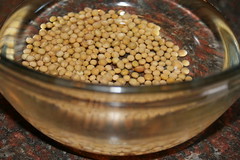
As my soybeans soak, allow me to describe my project: the Okara Project.
For nearly two years now, my household has been using a soymilk machine to produce our own soymilk. We do this both to save money and to cut down on the waste created by the milk cartons. The process is simple: First, you soak soybeans in water. Then you put them into the machine and let modern technology do your work for you. Penultimately, you strain the soybean pulp from the milk. Lastly, you clean out the soymilk machine.
The pulp that is separated from the milk is called okara. It is high in dietary plant fiber as well as protein. Although it is apparently a common cooking ingredient in Japanese cuisine, for a corn-fed American girl such as myself, it remains a constant source of befuddlement. Ninety percent of the time, it ends up on the top of my compost heap. When it comes to using it in my own cooking, I am at a loss.
This is a shame. I fork over money for organic soybeans and throw the bulk of them away, saving only what I extract as part of the soymilk-making process. I've been able to find a few recipes here and there, some in The Book of Tofu by Shurtleff and Aoyagi, some on the Internet. Very few of these recipes were "keepers."
Starting today, I will throw away as little okara as possible, and will try to come up with recipes myself. This process of trial and error will be documented in this blog, where I will share all of my successes and failures.
Good going!...Anna, Keep it up.....I also feel the same about okara.
ReplyDeleteEven if i can use it as a bio fuel, i will.....
I read a recipie for making okara tempeh though, on the net, but it was also not upto the expectations...
But still, i feel we will figure out something much better with okara....:)
Hi, Anna,
ReplyDeleteI've been making my own soymilk to make tofu for about 6 months now, and found your site while searching for recipes so I wouldn't waste the okara. How do you determine how much to use when you are adding it to recipes? I'd like to experiment, but I think I don't exactly understand what it functions as in a recipe. Does it replace eggs? I'm not vegan, but I've been trying to reduce egg consumption and only buy from a guy nearby who raises his chickens as pets. I'm hoping you can help me to understand better how it works in a recipe. Thanks! :)
Hi! I mostly go by my gut when adding okara to recipes. Sometimes I find recipes for baked goods that use pureed tofu, possibly as an egg replacer, and I've found that okara can be substituted for the pureed tofu with good results. But sometimes I'll look at a recipe I like, make some tweaks, and throw okara into the mix while taking out some of the flour and some of the liquid. That's really playing it by ear, though.
ReplyDeleteBefore I became vegan, a long time ago, I wasn't an experienced baker, so I can't exactly say if okara has egg-like functions (e.g., acts as a binder). It isn't traditionally used as an ingredient in baked goods, but rather as a substitute for rice in Japanese cuisine.
Sometimes you can sneak it into a soup (like split pea or anything that has been at least partially pureed) for extra protein and fiber.
I'd also like to experiment more with using it in sauces.
There are some interesting-looking recipes (that I haven't tried yet) on this page: http://veganfeastkitchen.blogspot.com/search/label/okara
I also highly recommend checking a used book store for "The Book of Tofu." Where I live, the vegetarian section has about a dozen copies of them in stock! So it might be easy to find. There is a whole chapter about okara in there, with some recipes (not necessarily vegan) and helpful information.
Great blog! Found nothing like it! Thank you :)
ReplyDelete